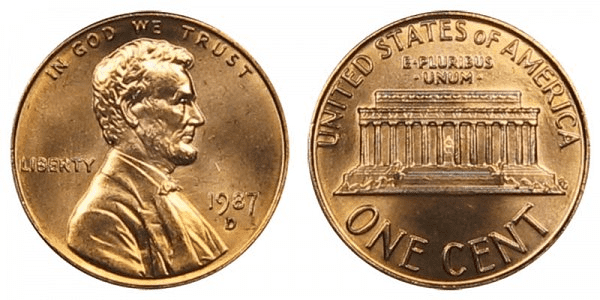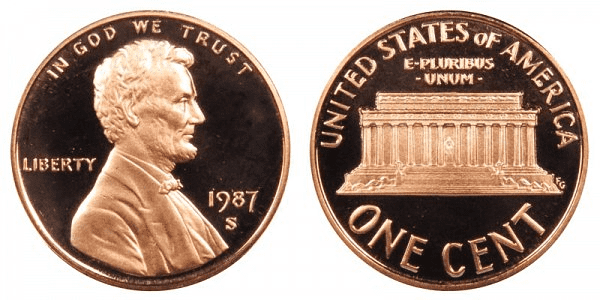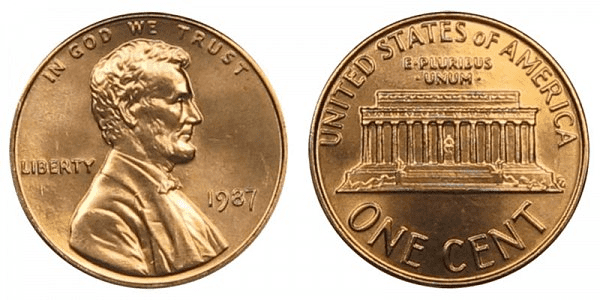What Is the 1987 Penny Made Of?
In terms of coin collecting, the 1987 Lincoln Penny is extremely current, and it is commonly encountered in change. Unless it’s a rare mistake coin, the 1987 penny’s worth is determined by its sentimental value. The ability of coins and coin collections to serve as a record of historical events that took place in a specific year is one of its most remarkable features.
They can also serve as a memento for someone who was born in that year or who had an important life event occur in that year.
The 1959 Lincoln Memorial reverse, designed by Frank Gasparro, took the place of the 1909 Brenner wheat stalk design that appeared on the 1986 cent. The Lincoln Memorial’s lower right side bears Gasparro’s initials, FG. The words “ONE CENT” are inscribed beneath the structure and around the rim, while the words “UNITED STATES OF AMERICA” are printed all the way around the upper half of the reverse along the rim.
The motto E PLURIBUS UNUM is inscribed between the words UNITED STATES OF AMERICA and the top of the Lincoln Memorial.
The Lincoln cent’s edge is plain and free of etching or reeding.
To reflect shifting metal prices, Lincoln Penny’s metal composition was altered in 1982. This indicates that, as opposed to the nickel and copper combination seen earlier, the 1986 Lincoln Penny is composed of 97.5% zinc and 2.5% copper.
1987 was a fair bit more peaceful year compared to the previous. In April, The Tracey Ullman Show airs the first “The Simpsons” animated short, and The Disney Corporation and France decide to build an amusement park. President of the United States Ronald Reagan gave a well-known address near the Berlin Wall in West Berlin.
1987 Penny Varieties
1987 D penny
Year: 1987
Face Value: $0.01
Composition: 97.5% zinc, 2.5% copper
Total Weight: 2.5g
Diameter: 0.750 in. 19.05 mm
Thickness: 0.0598 inches (1.52 mm)
Edge: Plain
Minted in: Denver
Quantity Minted: 4,879,389,514

photo source: www.usacoinbook.com
1987 S Proof Penny
Year: 1987
Face Value: $0.01
Composition: 97.5% zinc, 2.5% copper
Total Weight: 2.5g
Diameter: 0.750 in. 19.05 mm
Thickness: 0.0598 inches (1.52 mm)
Edge: Plain
Minted in: San Francisco
Quantity Minted: 4,227,728

photo source: www.usacoinbook.com
1987 No Mint Mark Penny
Year: 1987
Face Value: $0.01
Composition: 97.5% zinc, 2.5% copper
Total Weight: 2.5g
Diameter: 0.750 in. 19.05 mm
Thickness: 0.0598 inches (1.52 mm)
Edge: Plain
Minted in: Philadelphia
Quantity Minted: 4,682,466,931

photo source: www.usacoinbook.com
List of 1987 Penny Errors
Doubled Die Penny
The doubled die penny error is one of the most common mistakes (more correctly known as the doubled die penny).
Doubled die penny errors have some of the coin’s design or inscription doubled. This is because the die, which is used to generate the dies that strike coins, is impressed twice and at slightly different angles or directions in a hub.
There are a few 1987 doubled die mistake pennies that have a light doubling in the writing, date, Lincoln’s eye, and the columns of the Lincoln Memorial, but none that are known to be worth hundreds or thousands of dollars. Some doubled die coins from 1987 are worth $25 to $50 or more!
BIE Error
On some 1987 pennies, there is known to be a tiny vertical die crack in the little gap between the letters “B” and “E” in the word “liberty.” These coins are referred to as BIE variants. They often cost between $3 and $10.
Off-Center Penny
Off-center pennies lack some of their design because the dies did not strike the coin evenly when it was produced. Coins with 1% or 2% of their design lacking ranging to nearly blank sections make up the spectrum of off-centre faults. The most desirable of these faults are often 5% to 10% off-centre and lack around half of the design while still displaying the full date and mintmark (if applicable). 10% to 20% off-centre 1987 off-centre mistake pennies are worth about $10 to $20, whereas pennies with a complete date that are 50% off-centre can fetch up to $100.
Silver Penny
Silver pennies are one of the most frequently reported inaccuracies. Find a silver penny from 1987? It’s most likely merely the end result of a typical school experiment in which the zinc core’s silvery tint is chemically separated from the coin’s copper outer layer. There are stories of 1987 pennies, meanwhile, that were never copper-coated from the start and could be worth $50 or more.
How Much Is the 1987 Penny Worth Today?
1987 Lincoln There is no intrinsic metal value in pennies, which have a melt value that is about equal to their face value. Circulated pennies don’t have a value above their face value unless they have a specific quality.
| Coin | Condition
|
Value |
| 1987 No Mint Mark Penny | Uncirculated | 1987 pennies that have not been used before are often worth between 10 and 30 cents. 1987 Lincoln cents are substantially more valuable; the nicest ones can fetch hundreds of dollars!
That was unquestionably true of the 1987 cent with the highest value that lacked a mint stamp. It was given the MS68RD grade by Professional Coin Grading Service and fetched an astounding $546 at auction in 2008! |
| 1987-D Penny
|
Uncirculated | The value of the majority of uncirculated 1987-D Lincoln cents ranges from 10 to 30 cents.
A wealthy collector paid $1,998 in 2013 to purchase a 1987-D penny certified by Professional Coin Grading Service MS68RD, setting an all-time record price. |
| 1987-S Proof Penny | Proof | The 1987-S pennies were produced in relatively limited quantities, but they are very popular among collectors and can typically be purchased from a coin dealer for $1 to $3 each.
The 1987-S penny that sold for the highest price ever at a public auction was assigned the PR70DCAM grade by the Professional Coin Grading Service. In 2004, it changed hands for $2,070.
|
How Does The Grading System Work?
The Sheldon Scale is used by numismatists to provide a numerical value to coins. The Sheldon Scale goes from poor (P-1) to perfect mint state (P-1) (MS-70). Coins were originally evaluated using words to reflect their condition (Good, Fair, Excellent, Etc.). Unfortunately, coin collectors and dealers had different ideas about what each of these terms represent.
Professional numismatists joined together in the 1970s and established CoinGrading standards. These numismatists now assign grades at key places on the seventy-point scale, using the most regularly utilized numeric points in conjunction with the original adjective grade. The following are the most common coin grades:
-
-
- (P-1) Poor – Indistinguishable and probably damaged; if used, must have a date and mintmark; otherwise, rather battered.
- (FR-2) Fair – Nearly smooth, but without the damage that a coin graded Poor often possesses. The coin must have enough detail to be identified.
- (G-4) Fair – Inscriptions have merged into the rims in some areas, and important elements have been mostly erased.
- (VG-8) Very Good- A little weathered, but all of the primary design elements are visible, albeit faintly. There is little if any, central detail left.
- (F-12) Good – The item is very worn, yet the wear is even, and the overall design details stand out clearly. Rims are almost completely isolated from the field.
- (VF-20) Very Fine – Moderately weathered, with some finer features still visible. The motto or all letters of LIBERTY are readable. Both sides of the coin have entire rims that are separated from the field.
- (EF-40) Extremely Fine – Gently used; all gadgets are visible, and the most important ones are bold. The finer details are bold and clear, however, light wear may be seen.
- (AU-50) Uncirculated – Slight evidence of wear on the coin’s design’s high points; may have contact marks; eye appeal should be adequate.
- (AU-58) Uncirculated Choice – Slight traces of wear, no severe contact marks, almost full mint shine, and great eye appeal.
- (MS-60) Mint State Basal – Strictly uncirculated; no indication of wear on the coin’s highest points, but an unsightly coin with reduced luster, visible contact marks, hairlines, and other flaws.
- (MS-63) Mint State Acceptable – Uncirculated, but with contact scratches and nicks, little reduced shine, but otherwise appealing appearance. The strike is weak to average.
- (MS-65) Mint State Choice – Uncirculated with great mint shine, very little contact blemishes, and exceptional eye appeal. The strike is unusually severe.
- (MS-68) Mint State Premium Quality – Uncirculated with superb luster, no obvious contact marks to the naked eye, and exceptional eye appeal. The strike is quick and appealing.
- (MS-69) Almost Perfect Mint State – Uncirculated with perfect brilliance, a sharp and appealing strike, and extremely good eye appeal. A near-perfect coin with minor imperfections in the planchet, strike, and contact markings (seen only under 8x magnification).
- (MS-70) Mint State Perfect – Under 8x magnification, there are no tiny imperfections discernible; the strike is crisp, and the coin is perfectly centered on a beautiful planchet. Rarely seen on a coin, this coin is bright and whole, with original luster and exceptional eye appeal.
-
Where to Buy or Sell 1987 Penny?
Because 1987 Pennies are primarily valued as novelty or sentimental coins for people who were born in the year, got married in the year, or had other significant events occur in the year, flea markets, estate sales, and online marketplaces like eBay are the best places to purchase 1987 Pennies by the roll. When dealing with uncommon or valuable coins, such as the 1987 Pennies with flaws or those in excellent condition, working with reputable coin dealers and auction houses (like Heritage Auctions) is vital for additional piece of mind. If you’re unsure whether your penny has a more valuable mint fault or not, seek guidance in online communities.
FAQs
Is the error 1987 penny valuable?
Common 1987 Error Pennies can be worth $10-100+ making them a pretty nice find if you encounter them in your pocket change.
How much should a 1987 D penny weigh?
1987 D Pennies should weigh around 2.5g.
What is the rarest 1987 penny to look for?
The most rare 1987 pennies to look for aren’t those with errors, but those in exceptional condition. These coins can reach $500+.



